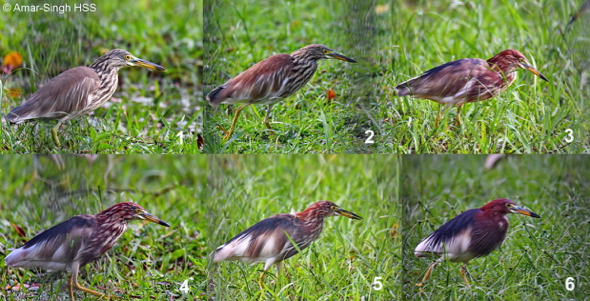“I had an opportunity this morning to observe Chinese Pond-herons (Ardeola bacchus) for 1.5 hours. There were 11 birds foraging together in a vacant large property, where they were offered some security by fencing and a gate. Some references (HBW 2019, IUCN-SCC Heron Specialist Group) suggest that they are usually solitary, in pairs or small flocks of 5-6 birds. But this has not always been my experience and I have seen larger number foraging together, like today. Wells 1999 says ‘forages alone, but loafs socially and is strongly gregarious when on the move and at roosts‘. Jeyarajasingam 2012 says ‘usually in loose flocks while feeding but gathers in large numbers when commuting between feeding and roosting sites‘.

“I have more to say about the foraging observations but want to start with plumage transition or changes from non-breeding to breeding. The 11 birds were in different stages of transition and I tried to document the change happening. I have made an assumption here that all the birds are Chinese Pond-herons (our vastly predominant migrant Pond-heron) and not the uncommon Javan or Indian Pond-herons.

“Of the 11 birds 4 were still in non-breeding plumage and the rest had changes, some significant enough to support they were Chinese Pond-herons. Note that I am not able to account for changes of 1st winter birds vs older adults or male vs female variation in plumage.

“The three composites above show key changes/transition of 6 birds – head and neck, side view and front view (this last composite is the least successful).
Bill Changes
“The bill in the non-breeding birds has a darker upper mandible. The distal one third is generally black in all phases but non-breeding birds may have some yellow at the tip of the lower mandible. The upper mandible gradually clears from black to orange-yellow. Note also that the yellow of the bill deepens to an orange-yellow. Note that bird 6 has still not fully developed breeding plumage as the upper mandible still has some black. However I have seen birds with yellow proximal bills and distal black bills whose plumage is still in transition and wonder if this is a sign of maturity (1st winter birds vs older adults) but I suspect more likely individual variation. Some references suggest that the bill turns bluish at the base in breeding but I have seen this feature in all the birds.
Plumage Changes
“One of the first changes that occurs is the darkening of the feathers on the mantle and back. The feathers of the head and neck then turn maroon and deepen to a rich wine-chestnut. While at the same time the mantle and back darkens to a deep black with extended plumes. Finally, the nape and breast develop extended maroon plumes.
“If you look at the head and neck composite you will note some variation in plumage transition. Note that bird 3 and 4 could be interchanged – bird 3 has a darker/richer neck but bird 4 a darker back and mantle. I chose this alignment after discussion with my wife and both of us agree independently (gut feeling). Also bird 4 and 5 look similar on the full body composite but the close-up shows that bird 4 has better developed plumage all round. I am only showing a few images here and watching them for 1.5 hours with 350 images and some videos does allow me to observe their features better.
“As always happy for comments and opinions.”
References:
1. Martínez-Vilalta, A., Motis, A. & Kirwan, G.M. (2019). Chinese Pond-heron (Ardeola bacchus). In: del Hoyo, J., Elliott, A., Sargatal, J., Christie, D.A. & de Juana, E. (eds.). Handbook of the Birds of the World Alive. Lynx Edicions, Barcelona available HERE.
2. The IUCN-SCC Heron Specialist Group. Heron Conservation: Chinese Pond-heron available HERE.
3. Wells, D.R. (1999) The birds of the Thai-Malay Peninsula: Vol. 1 (Non-Passarines). Christopher Helm, London
4. Allen Jeyarajasingam & Alan Pearson (2012) A Field Guide to the Birds of Peninsular Malaysia and Singapore. OUP Oxford.
Dato’ Dr Amar-Singh HSS
Ipoh, Perak, Malaysia
8th April 2019
Location: Ipoh, Perak, Malaysia
Habitat: Urban city environment









One Response
What a wonderful documentation of the plumage transition